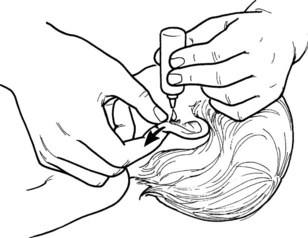This section may be photocopied and distributed to families. Spanish translation of this handout available at http://evolve.elsevier.com/Wong/clinical. 2. Wash your hands with soap and water. Count to 10 while washing, then rinse with clear water and dry with a clean paper or cloth towel. 3. Place the drug bottle in warm water. Cold drops in the ear are uncomfortable. 4. Feel a drop to make sure the drug is warm, not too cold or too hot. 5. Have the child lie on the side opposite the ear into which you will be putting the drug (right ear, on left side; left ear, on right side). If the child will not lie still, you can hold the child by sitting on a flat surface, such as the floor or bed. Place the child on her back with her head between your legs and her arms under your legs. If needed, you can cross your lower legs over the child’s legs to keep her from moving. 6. Check the ear to see if any drainage is present. If there is drainage, remove it with a clean tissue or cotton-tipped applicator. Do not clean any more than the outer ear. 7. Open the bottle of ear drops. Do not let the dropper portion touch anything. 8. The wrist of the hand you will be using is placed on the cheek or head. This will help steady your hand. 9. You will need to straighten the child’s ear canal. For children who are 3 years old and younger, pull the outer ear down and toward the back of the head (Figure 1). For older children, pull the outer ear up and toward the back (Figure 2).
Wilson & Hockenberry: Wong’s Clinical Manual of Pediatric Nursing, 8th Edition
Patient Teaching Guide
Giving Ear Medications
Instructions

![]()
Stay updated, free articles. Join our Telegram channel

Full access? Get Clinical Tree


Wilson & Hockenberry: Wong’s Clinical Manual of Pediatric Nursing, 8th Edition: Patient Teaching Guide
Get Clinical Tree app for offline access
